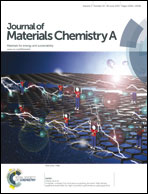A facile nanocasting strategy to nitrogen-doped porous carbon monolith by treatment with ammonia for efficient oxygen reduction†
Abstract
A series of novel nitrogen-doped hierarchical carbon monoliths (NCMs) with macroporous scaffolds composed of interconnected mesoporous rods were prepared successfully by a facile nanocasting strategy in combination with pyrolysis in a NH3 atmosphere. After etching off the hard template, the resulting NCMs had large macroporosity (up to 37.4 mL g−1) as well as large specific surface areas (1100–1600 m2 g−1), mesopore volumes (1.4–1.9 mL g−1), and narrow mesopore size distributions (3.8 nm). The nitrogen contents of the NCMs decreased from 4.7 to 1.6 at% with increasing pyrolysis temperature from 650 to 1050 °C. The pyridinic and graphitic nitrogen groups are dominant among various nitrogen-containing groups in the NCMs. Combined with their relatively high nitrogen-doping and unique hierarchical porous textures, NCM-750 exhibited comparable catalytic activity but superior long-term durability and methanol tolerance to commercial Pt/C for oxygen reduction reaction (ORR) with a four-electron transfer pathway in alkaline media. These excellent properties in combination with good recyclability and stability make these NCMs among the most promising electrocatalysts reported so far for efficient ORR in practical applications.


 Please wait while we load your content...
Please wait while we load your content...